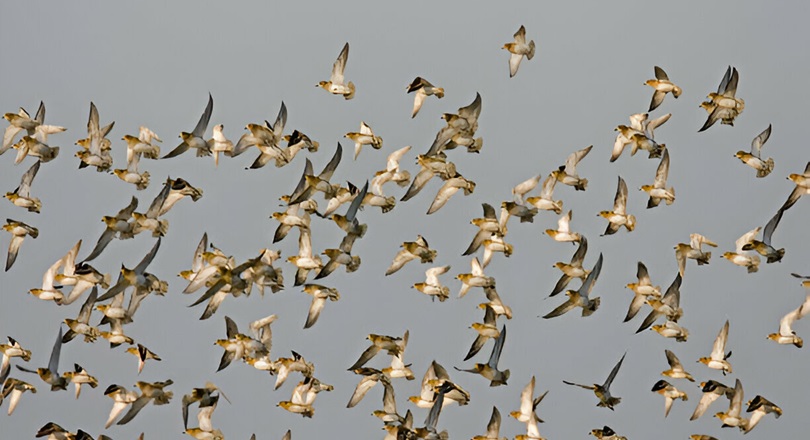Last Updated on February 28, 2025
Birds have always fascinated humans with their ability to soar through the sky, embodying freedom and grace. One of the most captivating aspects of their flight is the ascent stage, where a bird launches itself into the air, defying gravity with powerful, calculated movements. This article delves into the intricacies of the ascent stage, examining its mechanics, the factors influencing it, and its significance across different bird species.
Ascent Stage for a Bird
The ascent stage refers to the initial phase of flight where a bird transitions from being stationary on the ground or perched to gaining altitude. This stage is critical as it sets the foundation for sustained flight, whether the bird is taking off for migration, hunting, or simply moving to a new location. The ascent is a complex interplay of physical strength, aerodynamic principles, and environmental factors that together enable the bird to lift off successfully.
Read More >> 20 Black and White Birds with Red Heads
The Mechanics of Ascent
Initial Takeoff
The initial takeoff involves a powerful burst of energy as the bird propels itself upward. This action is often initiated by a strong leap using the legs, providing the necessary momentum for the wings to take over. Birds like sparrows and pigeons demonstrate remarkable agility and speed during this phase, leveraging their leg muscles to achieve an explosive start.
Wing Dynamics
Once airborne, the wings play a crucial role in gaining altitude. The primary feathers, or remiges, are responsible for generating lift. By flapping their wings in a specific pattern, birds create a difference in air pressure above and below their wings, enabling them to rise. The angle of attack—the angle at which the wing meets the oncoming air—must be carefully controlled to maximize lift without causing a stall.
Muscle Power
The ascent stage demands significant muscular effort, particularly from the pectoral muscles, which power the wings. These muscles are highly developed in birds, allowing for rapid and forceful wingbeats. For instance, hummingbirds exhibit an extraordinary wingbeat frequency, which enables them to hover and ascend with remarkable precision.
Read More >> 20 Black and White Birds in Colorado
Factors Influencing Ascent
Bird Size and Weight
The size and weight of a bird greatly influence its ascent capabilities. Smaller birds, such as finches, can achieve rapid takeoff due to their lighter bodies and higher wing-loading ratios. In contrast, larger birds like eagles and albatrosses require more energy and space to lift off, often utilizing thermals or wind currents to aid their ascent.
Wing Shape and Size
Wing morphology also plays a vital role in ascent. Birds with shorter, broader wings, such as quails, can generate quick bursts of lift, making them adept at rapid takeoffs. Conversely, birds with longer, narrower wings, like swifts, are optimized for sustained flight and may have a more gradual ascent phase.
Environmental Conditions
Environmental factors, including wind speed, air pressure, and temperature, significantly impact the ascent stage. Favorable winds can provide additional lift, while adverse conditions can hinder a bird’s ability to ascend. Birds have evolved to read and utilize these environmental cues, adjusting their takeoff strategies accordingly.
Examples of Ascent in Different Bird Species

Small Birds
Small birds, such as sparrows and chickadees, are masters of rapid ascent. Their lightweight bodies and high wing-loading allow them to achieve quick takeoffs, essential for escaping predators or navigating dense vegetation. Observing these birds reveals a burst of energy followed by rapid, agile wingbeats to gain altitude swiftly.
Medium-sized Birds
Medium-sized birds like pigeons and doves exhibit a more measured ascent. They rely on a combination of strong leg pushes and steady wingbeats to lift off. These birds often display a pronounced takeoff arc, where they initially gain height rapidly and then transition to a more level flight path.
Large Birds
Large birds, including eagles and albatrosses, face unique challenges during ascent. Their substantial body mass requires greater energy expenditure to lift off. These birds often use elevated perches or runways to gain initial momentum. Once airborne, they rely on thermal currents or wind gradients to assist in further ascent, conserving energy for long-distance flight.
Evolutionary Adaptations
Adaptive Traits
Over millions of years, birds have evolved various traits to enhance their ascent capabilities. For instance, the keeled sternum provides an anchor point for powerful flight muscles, while hollow bones reduce overall weight without compromising strength. These adaptations have enabled birds to exploit diverse ecological niches, from dense forests to open skies.
Comparative Analysis
Comparing ascent adaptations across species reveals fascinating insights. Hummingbirds, with their rapid wingbeats and lightweight bodies, can achieve vertical takeoff, akin to helicopters. In contrast, albatrosses have adapted to use wind currents over oceans, gliding with minimal energy expenditure. This diversity highlights the evolutionary ingenuity of birds in mastering the ascent stage.
Ascent Stage in Migratory Birds
Long-distance Ascent
Migratory birds face unique challenges during ascent, particularly when embarking on long journeys. Species like Arctic terns and bar-tailed godwits undertake extensive migrations, requiring efficient energy management. These birds often begin their ascent by capitalizing on favorable weather conditions and wind patterns, ensuring a strong start to their arduous journeys.
Energy Management
Energy conservation is crucial for migratory birds during ascent. They have adapted to optimize their flight muscles and utilize fat reserves as an energy source. Additionally, some species engage in stopover strategies, where they rest and refuel at key points along their migration route, ensuring they maintain the necessary energy levels for sustained ascent.
Challenges During Ascent
Predators
The ascent stage is a vulnerable period for birds, as they are exposed to predators. Raptors like hawks and falcons often exploit this vulnerability, targeting birds during takeoff. To counter this threat, many birds have evolved rapid ascent techniques and takeoff behaviors that minimize their exposure time.
Physical Limitations
Birds face inherent physical limitations during ascent. Factors such as wing loading, muscle strength, and overall fitness influence their ability to gain altitude. For example, older or injured birds may struggle with ascent, affecting their survival and reproductive success.
Environmental Obstacles
Natural barriers and environmental conditions pose significant challenges during ascent. Dense vegetation, urban structures, and turbulent air currents can hinder a bird’s ability to take off smoothly. Birds have adapted by developing agile flight patterns and using open spaces to initiate their ascent.
Human Impact on Bird Ascent
Urban Environments
Urban landscapes present unique challenges for birds during ascent. Tall buildings, glass structures, and limited green spaces can disrupt natural flight paths and increase the risk of collisions. Despite these obstacles, many bird species have adapted to urban environments, utilizing rooftops and artificial structures for takeoff.
Climate Change
Climate change affects bird ascent in various ways. Altered weather patterns, changes in wind currents, and shifting habitats can disrupt traditional takeoff strategies. Additionally, extreme weather events, such as storms and heatwaves, can pose immediate threats to birds during ascent, necessitating adaptive behaviors.
Conservation Efforts
Conservation initiatives play a vital role in supporting birds’ ascent capabilities. Creating and preserving natural habitats, establishing bird-friendly urban designs, and mitigating climate change impacts are essential measures. Public awareness and engagement in bird conservation efforts can help ensure that birds continue to thrive and navigate their environments successfully.
Conclusion
The ascent stage in bird flight is a remarkable display of strength, precision, and adaptability. From the initial leap to the powerful wingbeats that lift them into the sky, birds have evolved a multitude of strategies to master this critical phase. Understanding the mechanics, challenges, and adaptations associated with ascent not only deepens our appreciation for these avian marvels but also underscores the importance of conserving their habitats and ensuring their continued survival.
By observing and studying the ascent stage, we gain insights into the complex interplay of biology, physics, and environmental factors that enable birds to defy gravity and soar. As we continue to explore and protect the natural world, let us be inspired by the remarkable journey of birds from the ground to the sky, embodying the essence of freedom and resilience.
Additional Resources
For those interested in delving deeper into the topic, here are some recommended readings and visual aids:
- “The Flight of Birds” by David E. Alexander
- “Bird Flight Performance: A Practical Calculation Manual” by C.J. Pennycuick
- National Geographic’s documentary on bird flight dynamics
- Online databases and journals focusing on ornithology and avian biology
References
- Alexander, D. E. (2015). “On the Wing: Insects, Pterosaurs, Birds, Bats and the Evolution of Animal Flight”. Oxford University Press.
- Pennycuick, C. J. (2008). “Modelling the Flying Bird”. Academic Press.
- National Geographic. (2021). “Bird Flight Dynamics”.

